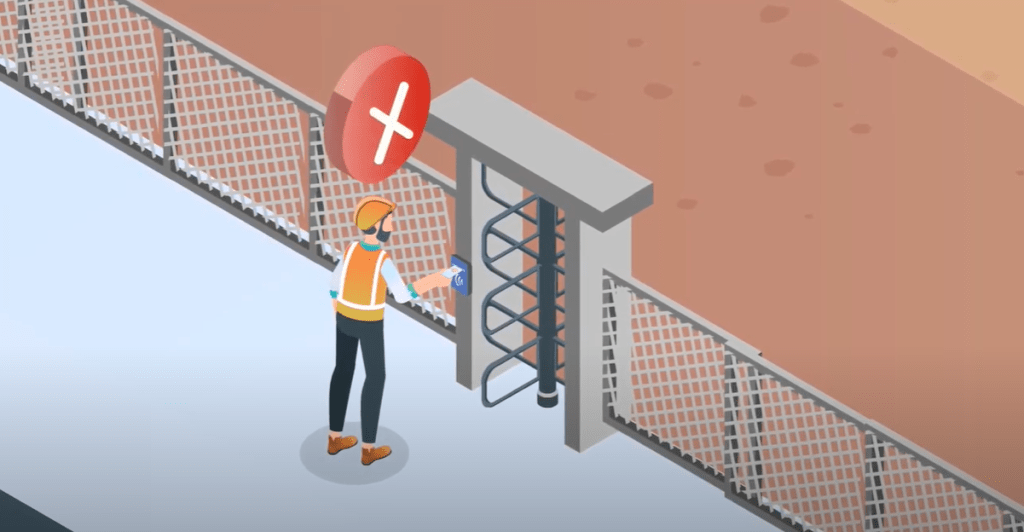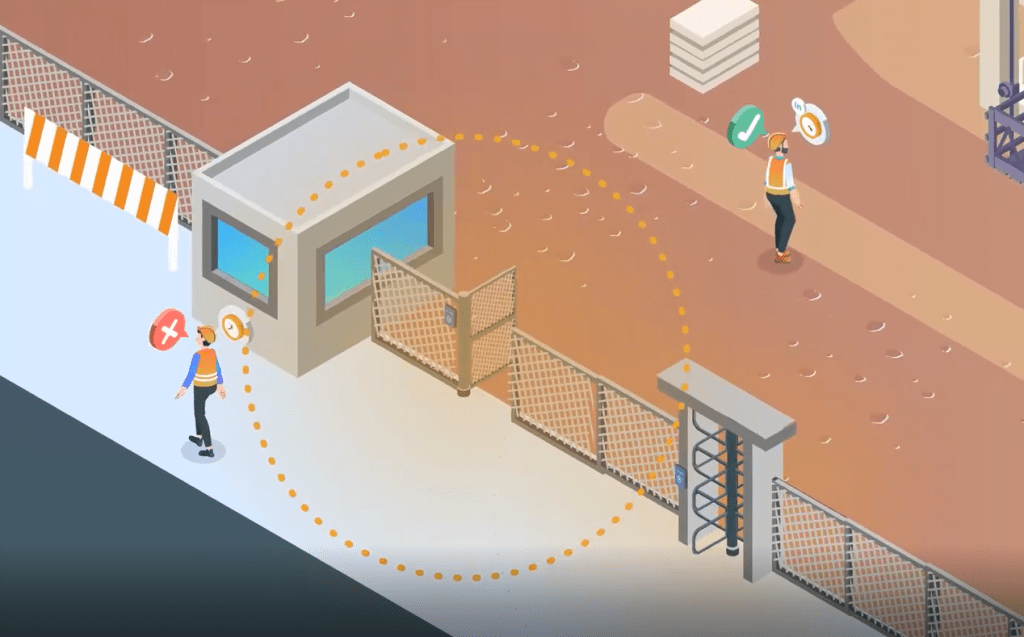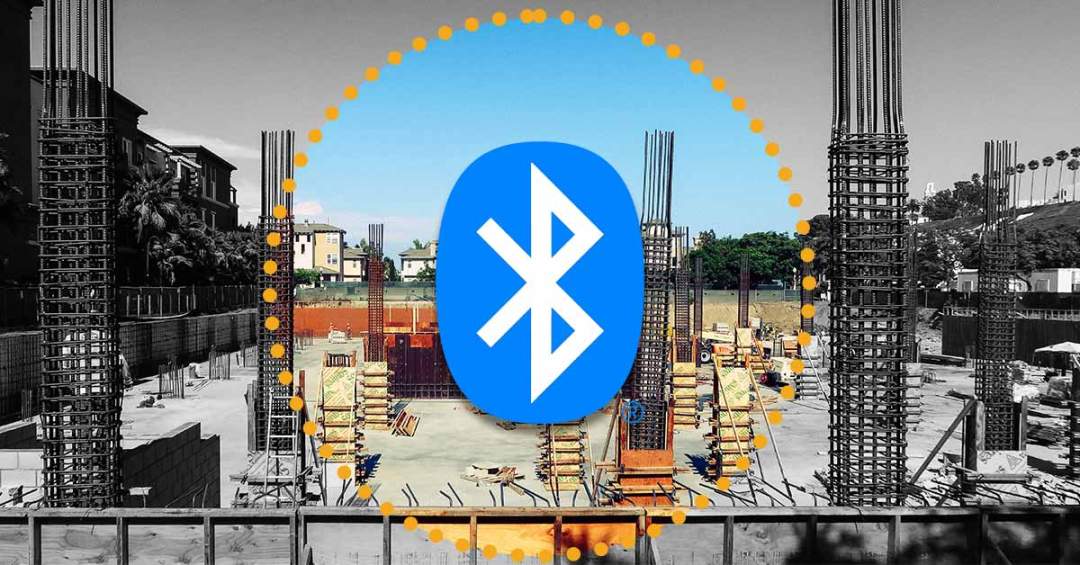Bluetooth low energy (BLE) is special type of wireless Bluetooth technology designed for short-range communication. However, unlike many of BLE’s relatives, this technology was developed for more industrial applications. Think lower data capacity, longer battery life, less capability, greater durability.
Morale of the story? BLE tech is tough, it lasts long, and is perfect for several construction applications.
Read on to find out more about Bluetooth low energy, how it compares to Bluetooth classic, Bluetooth low energy beacons, and what the technology is used for in construction.
Table of Contents
What is Bluetooth Low Energy?
Bluetooth Low Energy vs Bluetooth Classic
Bluetooth Low Energy Beacons
What are Bluetooth Low Energy Beacons Used for In Construction?
1. BLE for Indoor Navigation
2. BLE for Real Estate Promotions
3. BLE Asset Tracking
4. BLE Access Control
Using Bluetooth Low Energy for Passive Access Control
Conclusion
What is Bluetooth Low Energy?
Bluetooth low energy (BLE) is a type of Bluetooth technology that operates with minimal energy consumption and a lower data capacity than that of its older sibling, Bluetooth classic. This allows BLE-enabled devices to run on small batteries for extended periods of time and still share, transfer, or exchange data.
Bluetooth low energy is not new technology. In fact, BLE (or Bluetooth 4.0) hit the market way back in 2011. Though there is a lot of overlap between BLE functionality and Bluetooth classic functionality, these two technologies hail from quite unique lineages. In fact, what we now know as Bluetooth low energy was initially a Nokia project called “Wibree” before it was adopted by Bluetooth.
Today, Bluetooth low energy has emerged as one of the most versatile technologies for talking to a host of different devices and interfaces, including iOS, Android, Windows, and many more. But, before we dive too deep into BLE applications and uses, let’s explore the key differences between Bluetooth low energy and Bluetooth classic.
Bluetooth Low Energy vs Bluetooth Classic
Bluetooth classic and Bluetooth low energy solutions both aim to help users achieve the same goal: to wirelessly communicate information between devices for either personal or commercial use. However, there are some key differences between the two solutions that you should be aware of:
Bluetooth low energy vs Bluetooth classic:
| Bluetooth Classic | Bluetooth Low Energy | |
| Energy Consumption |
1 W, for reference High energy usage requires much greater battery capacity. Most standard Bluetooth-enabled devices need to be recharged weekly, or even daily. |
0.01 – 0.50 W, for reference Very low energy usage (after all, it’s in the name). BLE devices can generally last years on small batteries before being recharged or replaced. |
| Data Capacity |
1-3 mbit/s High volume data capacity. Able to transfer very complex information in a very quick fashion. |
125 kbit/s – 1 mbit/s Limited data capacity. Ideal for applications that transfer very basic information. |
| Time to Send Data | Typically 100ms | Typically 3ms |
| Use Cases | Primarily used for enabling wireless audio streaming for speakers, headphones, in-car audio, and more. Also used for personal wearable technologies and other applications that require continuous data streaming. | Bluetooth low energy technology is primarily used for novel applications, such as access control and door entry, blood pressure monitors, smart watches and wearables, public transportation apps, etc. |
| Voice Capable | Yes | No |
| Range | Up to 100m | Less than 100m |
| Security | 56/128-bit and application layer user defined. | 128-bit AES in CCM mode and application layer user defined. |
Bluetooth Low Energy Beacons
A Bluetooth low energy beacon, or BLE beacon, is a small radio transmitter that broadcasts BLE signals within a given range (device dependent). This signal can trigger different actions when it interacts with other compatible BLE-enabled apps or operating systems within range (generally mobile devices).
Bluetooth low energy beacons take many shapes and forms. Here are a few:
![]()
These BLE beacons can range in price from $10 to $25, depending on the manufacturer, specifications (range, supported protocol, battery life, durability, etc), and the volumes being procured.
Bluetooth low energy beacons are imperative to the implementation of many construction technologies. For example, BLE beacons facilitate location-based tracking of people and assets, help people navigate, can increase worker engagement/interaction, and create data points that can help Construction Managers and General Contractors to make more informed decisions.
Let’s explore some of those uses cases in more detail.
What are Bluetooth Low Energy Beacons Used for In Construction?
Bluetooth low energy technology is seeing increased adoption across various global industries. In fact, the global market for Bluetooth low energy solutions is projected to grow at an estimated compound annual growth rate (CAGR) of 19.68% between 2021 and 2026.
Here are some of the leading construction applications of BLE technology:
1. BLE for Indoor Navigation
GPS technology is effective for outdoor navigation, but it fails to provide the same level of direction in indoor settings. For large indoor settings, Bluetooth low energy beacons can be effective in providing extremely accurate and detailed navigational information.
Here’s how BLE navigation works:
- Multiple beacons are installed in various strategic points so that overlapping coverage is created
- Smart devices are tagged by multiple BLE beacons
- Based on the signal strength of multiple endpoints, a precise user location can be determined
- Detailed user directions can be delivered to the user’s smart device
Though this technology is predominantly used un settings external to the construction site (ex. multi-storey stores, large shopping malls, convention centers, conference floors, and museums), there are potential applications with helping construction workers navigate large campuses or complex/dangerous project sites.
2. BLE for Real Estate Promotions
Bluetooth low energy beacons are seeing increased adoption in the real estate sector. They are being used throughout the entire selling process, from attracting prospective buyers, to capturing leads, to promoting in-property engagement. For project owners that might be looking to secure renters prior to the completion of a construction project, there are a few strategies that can be deployed.
Here are a few examples of how BLE technology is enhancing the real estate experience.
Attracting buyers:
- Mounting beacons on “for sale” or “for rent” signs can give prospective buyers the opportunity to engage with a property and access detailed information from their mobile device.
- Broadcasting lists of other properties managed by the project owner, so potential buyers can see what else you have to offer.
- Creating virtual tours of what the completed space might look like, then casting these to mobile devices.
Capturing leads:
- Sending digital business cards to mobile devices
- Sending pricing information or “get a quote” forms to mobile devices
3. BLE Asset Tracking
Asset tracking is the usage of technology to track the movement of physical assets. This can be facilitated using GPS, RFID, LoRa, or Bluetooth low energy technologies. Each of these technologies have different preferred use cases, but there has been an emerging trend to leverage BLE beacons to enable the tracking of workers and assets on construction sites.
Here is how it works:
- Bluetooth low energy-enabled badges or sensors with unique IDs are issued to construction workers or attached to construction assets.
- BLE beacons are placed at strategic locations on a construction site.
- BLE beacons broadcast signals which are received by badges or sensors.
- Multiple beacons tagging the same badge/sensor make it possible for a precise position to be determined, creating a locational tracking effect.
- Or, more simply, badges and sensors can simply relay zonal information based on information exchange with a single beacon.
4. BLE Access Control
Bluetooth low energy access control is the usage of Bluetooth capabilities to wirelessly transit credentials or certifications, so that users can be verified and granted/restricted access by Bluetooth readers. In construction specifically, BLE access control pertains to the verification of worker certifications that are required for them to be conducting safe work on a construction site.
Read on to find out more about using Bluetooth low energy beacons and Bluetooth badges to facilitate passive access control.
Using Bluetooth Low Energy to Automate Time and Attendance
Bluetooth low energy devices are emerging as a powerful way for more traditional industries (like construction) to unlock previously inaccessible data on their workforce and automate critical workforce documentation, such as approved access and the tracking of time and attendance data.
To clarify, access control pertains to the physical and intellectual security of assets. In construction, access control is the implementation of technology to ensure that every worker that steps foot on a project site is properly trained and certified to be there.
Construction site access control can be implemented in one of two ways:
- Turnstiles, NFC badges, and NFC card readers. This is the more secure method of implementing construction site access control, which allows General Contractors to completely secure their site perimeter and prevent the risk of unwanted/unqualified traffic entering the site. This access control system is primarily utilized in busy urban centers where there is heavy foot traffic surrounding the site perimeter (ex. Manhattan).

Learn more: Construction Site Access Control
Here’s how it works:
- Turnstiles are installed at secure access points and outfitted with NFC-powered smart devices.
- Subcontractors must upload digital certification documentation for every worker that will be conducting work on the project.
- The General Contractor approves or denies that documentation.
- The worker is issued a NFC-powered badge that is paired to their approved worker profile.
- The worker scans that badge on the smart reader and the turnstile gate opens if the worker is approved to be on the project.
- Bluetooth low energy cards and BLE beacons. This is a less secure but more flexible access control system that does less to deter unwanted foot traffic but involves less work and less friction for project crews. This passive access control system is more widely utilized as it can be implemented in urban settings for high-rise builds just as easily as it can be used on large campus builds.

Here’s how it works:
- Subcontractors must upload digital certification documentation for every worker that will be conducting work on the project.
- The General Contractor approves or denies that documentation.
- The worker is issued a Bluetooth low energy badge that is paired to their approved worker profile.
- The worker enters the construction site through any approved access point and is passively verified by a Bluetooth beacon as soon as their BLE badge comes within range. Unqualified workers are flagged in a cloud-base database and can be addressed by project crews.
Interested in learning more about instigating passive access control on your project? Speak with a myComply representative today to find out more.
Conclusion
Bluetooth low energy technology is emerging as a powerful tool in capturing and leveraging previously inaccessible data from construction sites. By implementing BLE beacons, BLE badges, BLE sensors, and more, General Contractors can improve their site safety, ensure that projects move according to schedule/plan, and make more informed decisions.
Consider implementing Bluetooth low energy technology for:
- Indoor navigation
- Real estate promotion
- Asset tracking
- Passive access control
myComply is the leading solution for construction firms that are looking to implement a passive access control solution. myComply customers can enhance site safety, prevent the risk of regulatory fines, secure insurance reductions, and automate the collection of deep workforce data.
If you would like to explore the implementation of a Bluetooth low energy enabled access control solution for your next project, then book some time with a myComply product expert today!



